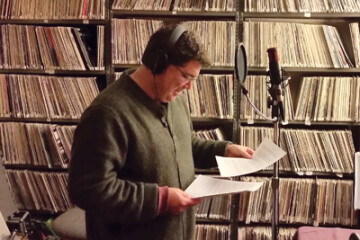Interview with Ken Egan Jr. Montana 1864: Indians, Emigrants, and Gold in the Territorial Year
As I tiptoed up the stairs at the Country Bookshelf to hear Ken Egan Jr. talk I could hear his friendly voice wafting down answering a question from the audience about his new book, Montana 1864, which chronicles the year Montana became a U.S. territory. I’d had the pleasure of speaking with Ken a few days prior about the book, and it was nice to see a good group of interested history-buffs gathered here for the book event.
During my conversation with Ken, the executive director for Humanities Montana, what stood out to me was how much he seemed to truly love Montana–its histories, places, and people. I could hear the excitement and warmth in his voice as he told me about some of his favorite (and least favorite) characters from the book. He talked about a few of these folks as fondly and familiarly as if they were old college buddies. Ken had this to say about a particularly interesting card named Johnny Grant: “He represented a possibility for Montana–he believed in mixed-race marriages, and didn’t take life too seriously. He was the kind of guy who was always finding the humor in things.”
JC: What did you learn about Montana’s history through your research?
KE: I found that Indian relations were much more complex, much more human, much more surprising than I thought when I started the project. I knew we had white emigrants moving into Indian Territory and violently dispossessing them, and that is the overarching historical narrative, but it turns out that there were many emigrants that were extremely sensitive to the lives and the needs and the pleasures of Indian life; many whom were very respectful. In some ways the mixed-race marriages that I describe in the book raise the question of if it was possible to join the races through mixed marriages and communities.
Unfortunately, from my point of view, that’s not the path that we followed or pursued.
JC: What role did gold play for Montana in 1864?
KE: I’m not going to call it a bribe, but I found it interesting that those who went back to Washington City carried gold with them and presented it to members of Congress to impress upon congress the importance of making Montana a territory. During the Civil War, the Union was running up a huge debt. The idea of being able to secure gold in order to off-set that debt is a big deal. The most persuasive point of the whole lobbying effort was the notion that we could extract gold right out of these soon-to-be Montana mines, and the federal government would be far more solvent as a result. It’s not by accident we’re called the Treasure State.
JC: How did the book come to be?
KE: As I mention in the introduction of the book, we visited the Montana Centennial Train in 1964 In Chicago during a stop on its way to the New York World Fair when I was a kid. I was fixated on this big painting of the Battle of Little Big Horn that was featured in one of the display cars. So, I went back to the image of that train when I had the idea for this book and thought, what kind of train would we build for the 150th Anniversary of Montana? I imagine the book in one sense as being that train, a virtual train if you will.
JC: Are you happy with how the book turned out?
KE: I’m very happy with the end result. The production is beautiful and quite engaging. I love the photos, and I think they are such rich narrative on their own. One of my favorites is the photo of Molly Sheehan and her father. You can really see that bond between father and daughter.
JC: What’s next for you?
KE: It’s been suggested that I write additional books that focus on other key years in Montana history: Montana 1889 – the year we became a state; Montana 1913 – the year the homestead movement took off; and Montana 1936 – an important year during the Great Depression including the building of the Fort Peck Dam. However, my current project is a novel based on my great grandfather’s immigration story. He came over from Ireland in 1847, and I’m intrigued by his story. Fiction writing is a challenge, and I love it. So that’s what I’m working on right now.
JC: What advice do you have for fellow writers?
KE: Follow a passion, find something you care about and commit to it. It’s critical to have good, trusted readers along the way too to tell you the truth about your drafts. It’s also a good idea to cultivate publishers early and often. I don’t think you can ever approach a publisher too early. The publisher will often become a guide or a helper to the actual creation to the book.
Here’s an excerpt from the book selected by Ken about our own John Bozeman: And who exactly is this John M. Bozeman, who has lent his name to a town, a pass, and a trail? As with many of the first white men to arrive in the gold-rush years, his past is hardly transparent. In truth, he does not seem to have lived an exemplary life, and his future is very much a make-it-up-as-you go affair. (p. 164)
Montana 1864 can be purchased online at www.riverbendpublishing.com or at the Country Bookshelf. All proceeds of the sale of this book go to Humanities Montana.

